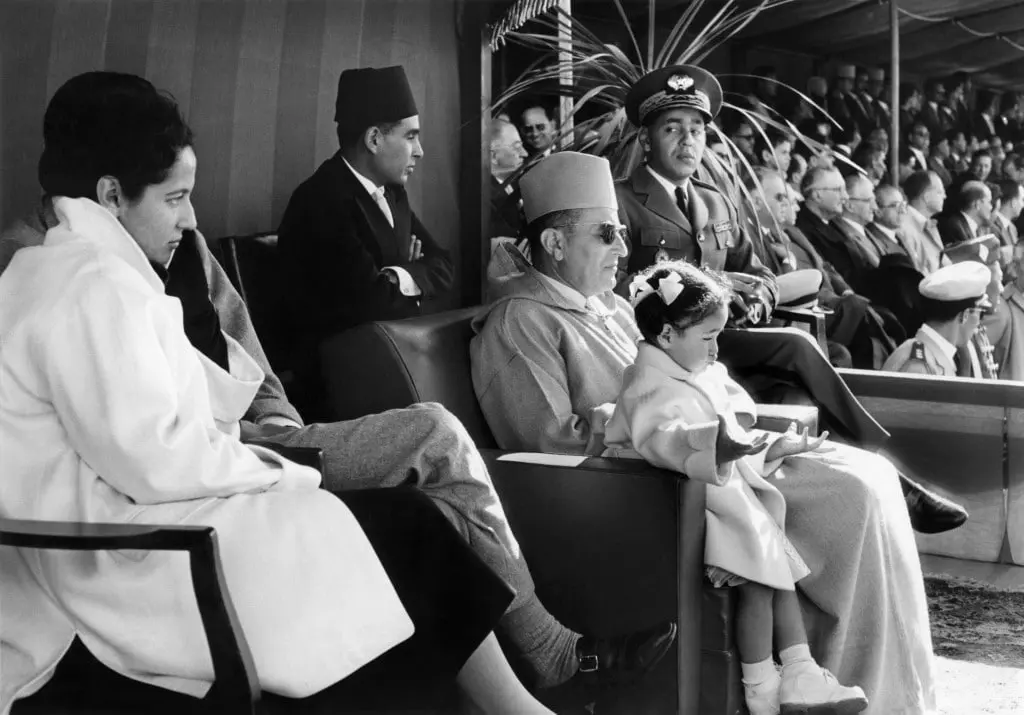
Introduction
Morocco’s colonial legacy was a mixed blessing: French rule left an infrastructure of 15,000 kilometres of roads, 1,600 kilometres of railways, and 35,000 hectares of irrigated land. The phosphate industry exported 4 million tonnes a year. However, 89 percent of Moroccans (including 98 percent of women) were illiterate, and most Moroccans held less than four hectares of unirrigated land.
There was no established army. Mohammed V appointed his son Prince Hassan as the first army commander. Hassan amalgamated the French and Spanish colonial armies and named Mohammed Oufkir Chief of Staff. Oufkir took part in the Liberation of France and was close to successive French Residents-General after the war. Mohamed ben Mizzian, one of Franco’s commanders during the Spanish Civil War, was made its principal commander, and became its only ever Field Marshal. The Army of Liberation that had its heartland in the Rif and fought the Spanish and French armies in the far south, was largely left out.
The Reign of Mohamed V (1956-60)
Istiqlal, the biggest party, dominated the government and called for a constitutional monarchy. It identified closely with the king, as Mohammed V now called himself, but he refused to be overshadowed. Istiqlal talked of a “Greater Morocco,” including Spanish Sahara, Mauritania and southern Algeria. It was a coalition of left-wing trade unionists, led by Mehdi Ben Barka, and conservative nationalists. A new modernist Parti de l’Indépendence was founded just after independence. In 1957 leaders of the Liberation Army, including Mahjoubi Aherdane, set up the Mouvement Populaire based in the countryside, among the Amazigh.
The Liberation Army’s heartland was the Rif, where its commander refused to place his troops under Istiqlal’s command. In October 1958, violence erupted across the central Rif, centred in ibn Abd al-Karim al-Khattabi’s tribe, the Aith Waryaghar and led by one of his relatives. Crown Prince Hassan used 20,000 troops to crush the rebellion, and impose a brutal collective punishment.
In 1959, Istiqlal split, and Mehdi Ben Barka formed the Union National des Forces Populaires from its left wing. The King found it useful to fragment the nationalist movement, so Morocco did not become a one-party state, but it was not a liberal democracy either. The regime was threatened by Arab nationalism, which opposed monarchs, Israel, and the United States, all of which the Moroccan regime viewed with favour. Prince Hassan negotiated an end to US bases in 1959, which fended off criticism, and in 1960 he became Minister of Defence and deputy Prime Minister. He succeeded his father in February 1961.
The Reign of Hassan II (1961-1999)
Hassan II oversaw the formulation of the Moroccan Constitution and the first legislative elections. He manipulated the political parties, ruled the countryside through rural qa’ids (administrators), and controlled the army personally. He justified his actions by posing as a religious leader, Commander of the Faithful (amir al-muminin). This policy kept him in power for nearly forty years.
The first Constitution (18 November 1962) declared Morocco to be a monarchy ruled by the Alaouite family and with the king as Commander of the Faithful. It kept the facade of a multi-party parliamentary system, which helped fragment the opposition. Effective opponents were ruthlessly repressed by Mohammed Oufkir, King Hassan’s chief of security. In 1965, he organised the kidnapping and murder of Ben Barka, who was exiled in Paris.
The economic crisis was acute. The king continued to rely on capital-intensive and export-oriented agriculture, but production for the home market stagnated. Rural development was stalled, and in the mid-1960s, people began to migrate to Europe or to settle in the cities in the bidonvilles, where the informal sector grew. By the early 1970s, external debt was 23 percent of GDP and inflation 17 percent a year. Phosphates kept Morocco afloat. To cope with protest, Hassan II’s second Constitution (1970) concentrated more power in his hands.
International Relations
International circumstances pulled the government in different directions. In the first years of independence, the government flirted with both sides in the cold war and the Palestinian-Israeli conflict. French and British forces invaded Egypt in 1956 and the newly independent government broke relations with France. The US provided an alternative source of support, but like other newly independent African states, the regime also flirted with the Soviet bloc. That did not last long, but the regime did insist that US forces should evacuate their big airbase at Nouasser, near Casablanca. Then it banned the Moroccan Communist Party.
Similarly, the regime was not anti-Jewish. Although many Jews started to leave for Israel, Jews remained in high positions in the administration. In the 1960s King Hassan had developed close but clandestine ties with Israel, although Morocco did not acknowledge that openly or break Arab unity over the issue. During the Six Day War in 1967 Moroccan forces were sent to help other Arab states against Israel, although the war was over before they arrived. In 1973 there was another Moroccan military involvement on the Arab side in the October (or Yom Kippur) War.
Threats to the Regime
In 1971, Oufkir crushed an attempted coup. The next year he himself was behind a second coup attempt. Oufkir died in obscure circumstances and his wife and young children spent the next twenty years in a harsh desert prison. For the rest of his reign, King Hassan’s new security chief, Driss Basri, oversaw a determined repression.
King Hassan now aligned the regime closely with the western alliance of the Cold War. The Ben Barka affair was forgotten and Hassan called President Giscard d’Estaing his “copain.” In the 1970s France and the US provided huge amounts of arms; the US stored nuclear bombs in Morocco. Even so, in 1978, the regime signed what was then the largest commercial deal ever signed between the Soviet Union (USSR) and a developing country. It bartered fishing grounds and the supply of phosphate against a loan of $2 billion.

